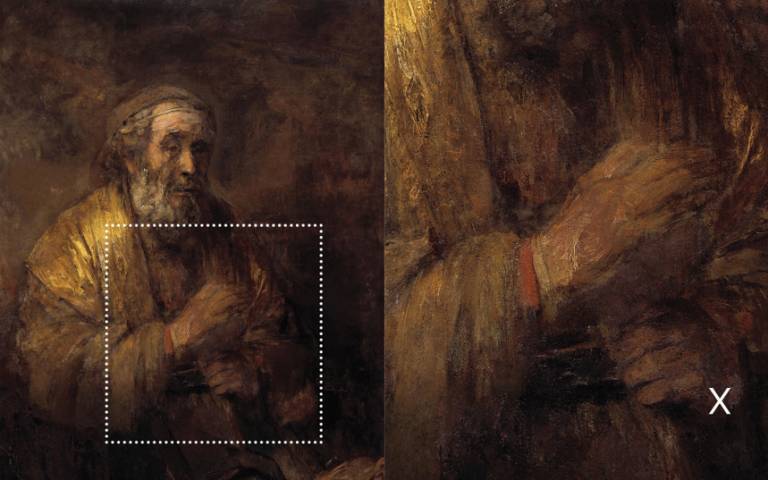Saving Old Master paintings with chemistry
28 January 2019
White, lead-rich deposits on the surface of Rembrandt’s Homer, a treasured oil on canvas from 1663, have been characterised by a team involving UCL Chemists which will help the conservation of many Old Master paintings.

The finding is particularly timely given the celebrations occurring throughout 2019 to mark 350 years since the death of Rembrandt and the Dutch Golden Age.
The study, published in Chemical Communications, reveals how the lead-containing paint has reacted with atmospheric pollutants including sulphur dioxide to form a white crust that disfigures the painting.
Using this information, conservators will now be able to further investigate this degradation process with the aim of preventing crusts from forming and to improve future conservation treatments of Old Master paintings.
Like many Old Masters, Homer has a long and eventful past which has taken its toll on the painting’s chemistry. The test of time and environmental factors, combined with the painting’s history, caused a barely visible, white crust to form on the surface of the painting.
Unfortunately for Homer, complete removal of the crust is not possible without damaging the original paint layer, since the surface deposits and the paint are so closely intertwined.
“We’re most excited that the approach we have developed makes it possible to identify, with much greater confidence, how the painting has evolved chemically with time. This information is crucial as it guides best practice in conservation and restoration science so that future generations can admire Old Masters as the artist intended,” said study co-author Professor Andrew Beale (UCL Chemistry).
To identify the complex chemistry of this white crust, a micro-sample of the damaged paint was carefully prepared and analysed by a team from UCL, the Mauritshuis in the Hague, the Rijksmuseum in Amsterdam, University of Amsterdam, Finden Ltd and Diamond Light Source.
The paint sample was imaged using X-ray Diffraction Computed Tomography to understand the evolving solid-state lead chemistry from the painting surface and beneath.
Lead author, Stephen Price from Diamond Light Source and Finden Ltd, explained: “Synchrotron facilities are incredibly useful for situations where you have a very small amount of a precious sample and require as much information as possible from it. Our sample was less than 100 µm, less than the width of a hair, so a lab-based source wouldn’t have the resolution to image such a small volume.”
Claire Murray co-author from Diamond Light Source added: “Old master paintings are irreplaceable, so the chemical reactions happening need to be understood to guide conservation strategies and synchrotron techniques are a critical tool for these studies.
“The technique we used uses diffraction to take a ‘fingerprint’ of the different chemicals present and tomography to take a 3D picture of the distribution of different species throughout the paint stratigraphy. This is a very powerful combination which has enabled the identification of the chemistry occurring in the different layers in the painting.”
The white crust on the surface was identified as a complex mixture of lead sulfates - a mixture of palmierite and anglesite, which are sulfur-rich minerals.
These have formed due to the reaction of the chemicals in the surface layers with the toxic gases from harsh environments the painting has experienced in the past before it had entered the Mauritshuis collection.
From the sulfur:lead ratios throughout the paint layer, the authors conclude that sulfur is from an external source in the form of sulfur dioxide, and that the nature of the lead sulfate product is dependent on the degree of diffusion/absorption of sulfur dioxide into the paint layers.
This lead sulfate product is directly contributing towards the formation of the white crust on the surface of the painting and so understanding the chemistry enables conservation scientists to identify the best treatments.
Moving deeper into the painting’s layers, lanarkite and leadhillite dominate, which indicate the permeation of the sulfur through the paint layers but to a lesser extent than is seen in the upper paint layers.
Lead soaps of palmitate and azelate, and hydrocerussite all follow, just above the chalk-based ground. The co-existence of lead soaps and lead (potassium) sulfates suggests that there are multiple chemical reactions occurring in the painting; soap formation, movement of lead through the paint layers and the formation of sulfate-minerals all reflect the tumultuous history of the painting.
Links
- Research paper in Chemical Communications
- Professor Andrew Beale's academic profile
- UCL Chemistry
- UCL Mathematical & Physical Sciences
Image
- Rembrandt's Homer (credit: Mauritshuis)
Source
Media contact
Bex Caygill
Tel: +44 (0)20 3108 3846
Email: r.caygill [at] ucl.ac.uk
 Close
Close

